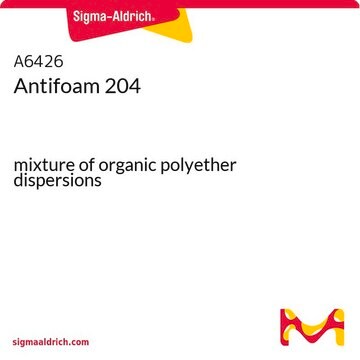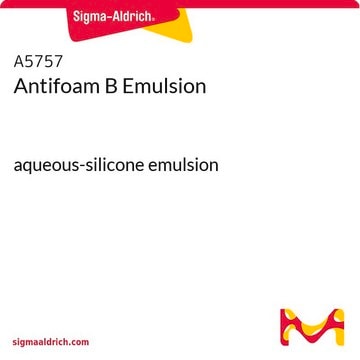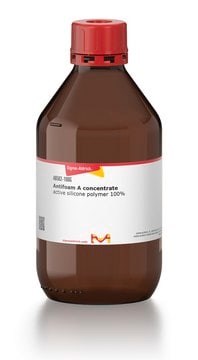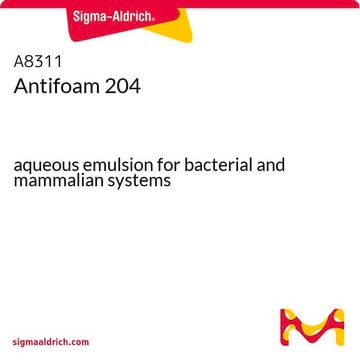The particle size of this product is not determined. However, silicon-based antifoam formulations have a general particle size range of 10um - 40um.
Kluczowe dokumenty
A8011
Antifoam C Emulsion
aqueous-silicone emulsion
Synonim(y):
Środek przeciwpieniący Emulsja
Wybierz wielkość
862,00 zł
Wybierz wielkość
About This Item
862,00 zł
Polecane produkty
pochodzenie biologiczne
synthetic
Poziom jakości
Formularz
emulsion
zawiera
emulsifier
metody
cell culture | hybridoma: suitable
microbiological culture: suitable
mp
0 °C (32 °F)
Powiązane kategorie
Opis ogólny
Zastosowanie
- as a supplement in RO-H2O and a chemically defined culture medium to determine volumetric mass transfer coefficient (kLa) of mammalian cell culture[2]
- as a component of feed medium[2],
- as a steam-sterilized antifoaming agent in a biocontroller for pH-stat fed-batch cultivations[3]
- as a supplement in fed batch medium to mimic the typical large-scale cultivation conditions[4]
Cechy i korzyści
- Minimizes compatibility issues with biological systems
- Highly effective defoamer at low concentrations
- Highly effective and versatile silicone defoamer
Inne uwagi
Hasło ostrzegawcze
Warning
Zwroty wskazujące rodzaj zagrożenia
Zwroty wskazujące środki ostrożności
Klasyfikacja zagrożeń
Eye Irrit. 2 - STOT SE 3
Organy docelowe
Respiratory system
Kod klasy składowania
10 - Combustible liquids
Klasa zagrożenia wodnego (WGK)
WGK 3
Temperatura zapłonu (°F)
Not applicable
Temperatura zapłonu (°C)
Not applicable
Środki ochrony indywidualnej
Eyeshields, Gloves, type ABEK (EN14387) respirator filter
Wybierz jedną z najnowszych wersji:
Certyfikaty analizy (CoA)
Nie widzisz odpowiedniej wersji?
Jeśli potrzebujesz konkretnej wersji, możesz wyszukać konkretny certyfikat według numeru partii lub serii.
Masz już ten produkt?
Dokumenty związane z niedawno zakupionymi produktami zostały zamieszczone w Bibliotece dokumentów.
Klienci oglądali również te produkty
-
What is the particle size range of the silicone emulsion particles in this anti-foam. Thank you!
1 answer-
Helpful?
-
-
How can I determine the shelf life / expiration / retest date of this product?
1 answer-
If this product has an expiration or retest date, it will be shown on the Certificate of Analysis (COA, CofA). If there is no retest or expiration date listed on the product's COA, we do not have suitable stability data to determine a shelf life. For these products, the only date on the COA will be the release date; a retest, expiration, or use-by-date will not be displayed.
For all products, we recommend handling per defined conditions as printed in our product literature and website product descriptions. We recommend that products should be routinely inspected by customers to ensure they perform as expected.
For products without retest or expiration dates, our standard warranty of 1 year from the date of shipment is applicable.
For more information, please refer to the Product Dating Information document: https://www.sigmaaldrich.com/deepweb/assets/sigmaaldrich/marketing/global/documents/449/386/product-dating-information-mk.pdfHelpful?
-
-
How is shipping temperature determined? And how is it related to the product storage temperature?
1 answer-
Products may be shipped at a different temperature than the recommended long-term storage temperature. If the product quality is sensitive to short-term exposure to conditions other than the recommended long-term storage, it will be shipped on wet or dry-ice. If the product quality is NOT affected by short-term exposure to conditions other than the recommended long-term storage, it will be shipped at ambient temperature. As shipping routes are configured for minimum transit times, shipping at ambient temperature helps control shipping costs for our customers. For more information, please refer to the Storage and Transport Conditions document: https://www.sigmaaldrich.com/deepweb/assets/sigmaaldrich/marketing/global/documents/316/622/storage-transport-conditions-mk.pdf
Helpful?
-
-
Will there be a problem if I add 100ppm of antifoam when cultivating bacteria?
1 answer-
This product is typically effective at 1-10 ppm. Therefore, there is no guarantee how 100 ppm will perform for bacteria cultivation.
Helpful?
-
-
Can the antifoam be autoclaved pure? When diluted (e.g. to 0.5% or 0.1%)?
1 answer-
Yes, this product may be autoclaved. Autoclaving the pure product may result in phase separation and might require remixing the emulsion.
Helpful?
-
Active Filters
Nasz zespół naukowców ma doświadczenie we wszystkich obszarach badań, w tym w naukach przyrodniczych, materiałoznawstwie, syntezie chemicznej, chromatografii, analityce i wielu innych dziedzinach.
Skontaktuj się z zespołem ds. pomocy technicznej













